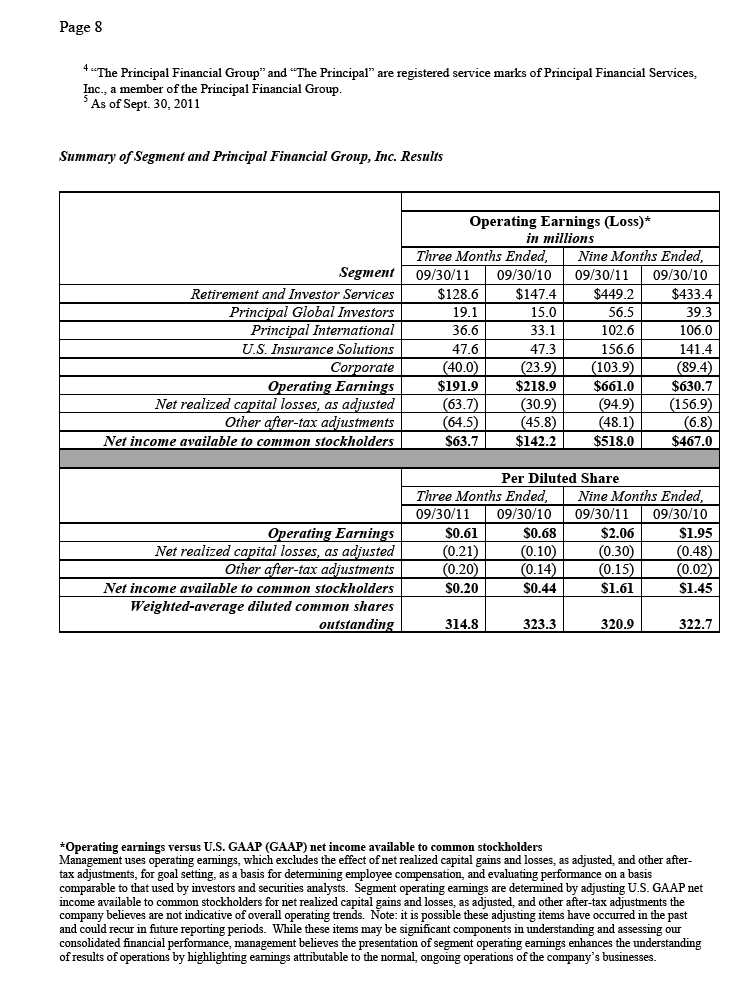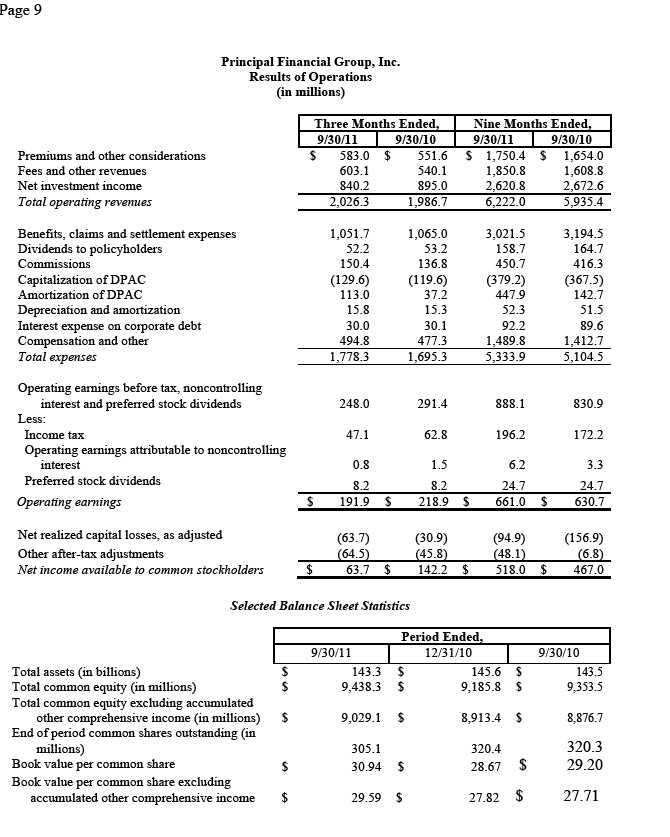|
| Page 6 |
| |
| Segment operating revenues for third quarter 2011 were $734.3 million compared to $690.7 million |
| for the same period a year ago due to higher premiums and fees in Individual Life and positive trends in both |
| sales and client retention in Specialty Benefits. |
| |
| |
| Corporate |
| Operating losses for third quarter 2011 were $40.0 million compared to operating losses of $23.9 |
| million in third quarter 2010 primarily due to lower variable investment income on excess capital at the holding |
| company due to negative marks caused by widening of credit spreads. |
| |
| Forward looking and cautionary statements |
| This press release contains forward-looking statements, including, without limitation, statements as to |
| operating earnings, net income available to common stockholders, net cash flows, realized and unrealized |
| gains and losses, capital and liquidity positions, sales and earnings trends, and management's beliefs, |
| expectations, goals and opinions. The company does not undertake to update these statements, which are |
| based on a number of assumptions concerning future conditions that may ultimately prove to be inaccurate. |
| Future events and their effects on the company may not be those anticipated, and actual results may differ |
| materially from the results anticipated in these forward-looking statements. The risks, uncertainties and |
| factors that could cause or contribute to such material differences are discussed in the company's annual report |
| on Form 10-K for the year ended Dec. 31, 2010, and in the company’s quarterly report on Form 10-Q for the |
| quarter ended June 30, 2011, filed by the company with the Securities and Exchange Commission, as updated |
| or supplemented from time to time in subsequent filings. These risks and uncertainties include, without |
| limitation: adverse capital and credit market conditions may significantly affect the company’s ability to meet |
| liquidity needs, access to capital and cost of capital; continued difficult conditions in the global capital markets |
| and the economy generally; continued volatility or further declines in the equity markets; changes in interest |
| rates or credit spreads; the company’s investment portfolio is subject to several risks that may diminish the value |
| of its invested assets and the investment returns credited to customers; the company’s valuation of securities may |
| include methodologies, estimations and assumptions that are subject to differing interpretations; the |
| determination of the amount of allowances and impairments taken on the company’s investments requires |
| estimations and assumptions that are subject to differing interpretations; gross unrealized losses may be realized |
| or result in future impairments; competition from companies that may have greater financial resources, broader |
| arrays of products, higher ratings and stronger financial performance; a downgrade in the company’s financial |
| strength or credit ratings; inability to attract and retain sales representatives and develop new distribution |
| sources; international business risks; the company’s actual experience could differ significantly from its pricing |
| and reserving assumptions; the company’s ability to pay stockholder dividends and meet its obligations may be |
| constrained by the limitations on dividends or distributions Iowa insurance laws impose on Principal Life; the |
| pattern of amortizing the company’s DPAC and other actuarial balances on its universal life-type insurance |
| contracts, participating life insurance policies and certain investment contracts may change; the company may |
| need to fund deficiencies in its “Closed Block” assets that support participating ordinary life insurance policies |
| that had a dividend scale in force at the time of Principal Life’s 1998 conversion into a stock life insurance |
| company; the company’s reinsurers could default on their obligations or increase their rates; risks arising from |
| acquisitions of businesses; changes in laws, regulations or accounting standards; a computer system failure or |
| security breach could disrupt the company’s business, and damage its reputation; results of litigation and |
| regulatory investigations; from time to time the company may become subject to tax audits, tax litigation or |
| similar proceedings, and as a result it may owe additional taxes, interest and penalties in amounts that may be |
| material; fluctuations in foreign currency exchange rates; and applicable laws and the company’s stockholder |
| rights plan, certificate of incorporation and by-laws may discourage takeovers and business combinations that |
| some stockholders might consider in their best interests. |

